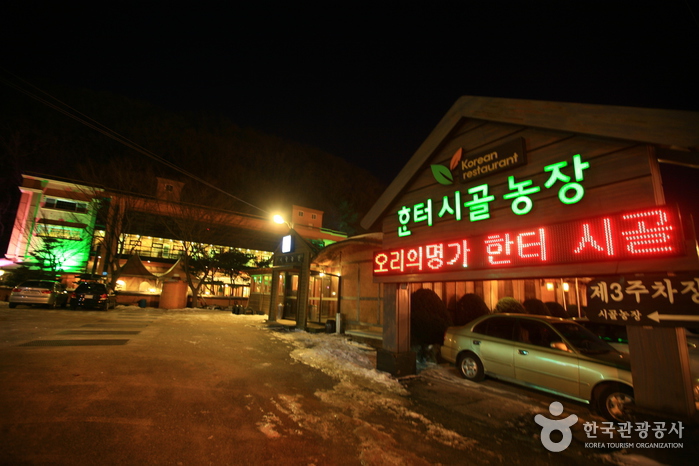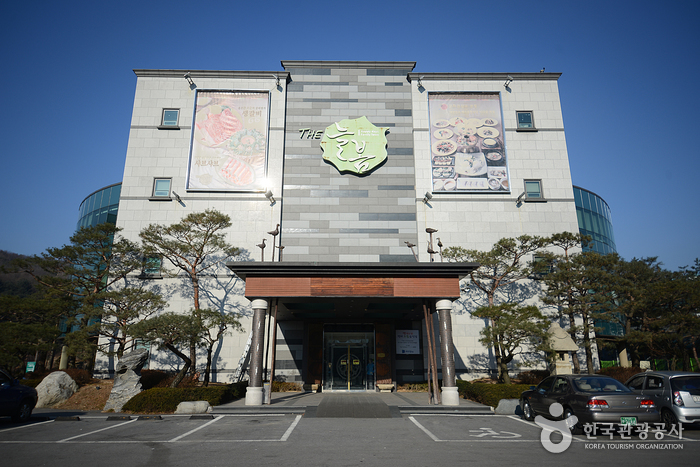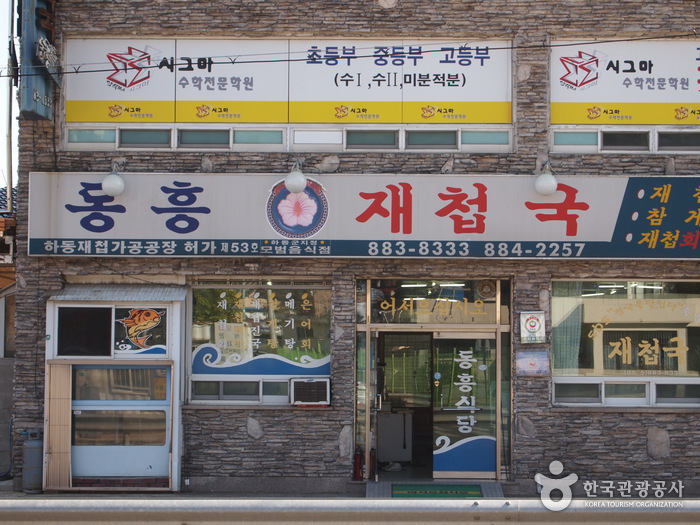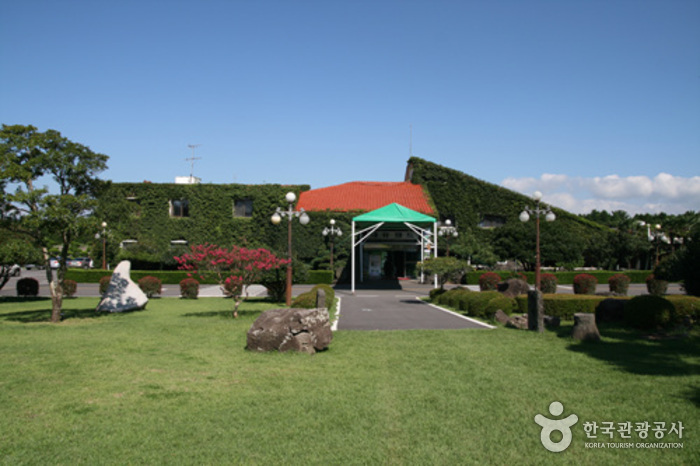Sigol Nongjang Garden
2008-02-27
765 Daedae-ri, Yangi-myeon, Yongin-si, Gyeonggi-do
Located at the entrance of Asiana Golf Club in Yongin, Sigol Nongjang Garden offers healthy duck delicacies in personalized dining rooms.
The excellent service staff, attired in traditional Korean garb, serves duck soup made with carefully selected medicinal herbs.
Furthermore, the restaurant also raises its own ducks for the dishes.
Neulbom Garden
2020-01-09
45-10 Janghyeon-ri, Jingeon-eup, Namyangju-si, Gyeonggi-do
Located within 5 minutes from Gwangreung Arboretum, Neulbom Garden welcomes diners not only with a beautiful view and elegant service but also with wonderful cuisine away from hectic city life.
The convenience of nearby popular attractions like Bearstown Ski Resort and Ildong Sulfuric Spa is another aspect that makes Neulbom Garden more appealing.
The restaurant also features a large yard with traditional Korean games for families.
Dongheung Jaecheop Sikdang
2008-02-27
221-43 Gwangpyeong-ri, Hadong-eup, Hadong-gun, Gyeongsangnam-do
Dongheung Jaecheop Sikdang specializes in soup made of ‘jaecheop’, a kind of small shellfish and is located near Hadong Police Office.
Having ‘jaecheop’ soup is known to strengthen liver functions by relieving one’s fatigue.
The experienced owner prepares the soup only with the natural shells harvested from Seomjingang River nearby.
Seasoned with natural ‘bucho’ (duckweed), jaecheop soup has a sweet scent and a great taste.
Also, try Dongheung’s sweet and sour ‘jaecheop hoe’ (raw shellfish mixed with vegetables in sweet and sour hot sauce).
Dishes served like a family style meals.
Daeyu Sikdang
2010-04-10
144 Sangye-dong, Seoguipo-si, Jeju-do
82-64-738-0500
Located near a preservation, you can interestingly enough savor the natural environment and foods, and even the sounds of the hunting grounds.
Daeyu Sikdang is the original inventor of pheasant dishes in Korea and features excellent services like an English menu, clean restrooms, open kitchen and neat atmosphere.
Annually, 50,000 pheasants are raised while hosting 100,000 foreign visitors.
Broth made of pheasant and a dish called ‘shabu shabu’ (cooking thin slices of meat in a clean broth) are quite popular.
Most of the serving staff can speak either English or Japanese, and various modern facilities are available.
An interesting hunting theme restaurant.
Geumsan Samgyetang
2016-09-05
320-1 Sang-dong, Suseong-gu, Daegu
A superb restaurant located in the Food Complex of Suseong Mot Deulangil.
Suseong Mot Deulangil is Daegu’s main tourist attraction.
Geumsan Samgyetang’s Renaissance architecture and modern, high-class interior design produce an exquisite atmosphere to dine.
The graceful greetings of the service staff attired in uniforms puts grin on the visitor’s face.
With 10 years of experience in preparing ‘samgyetang’ (stewed ginseng-stuffed chicken), Geunsan has many patrons who favor and include in their tour of Daegu.
Geumsan also provides travel information of Daegu for those who pay a visit.
Bakdaegamdaek Sutbulgalbi
2016-09-05
442-7 Gambuk-dong, Hanam-si, Gyeonggi-do
The restaurant’s traditional Korean style architecture, decorated with an earthy wooden style and rice paper covered antiques, x_heightens its reputation as a fine dining facility.
This famous Korean restaurant introduces healthy menus filled with oriental herbs like Chinese matrimony vines, hedysarum roots, and so on.
Bakdaegamdaek’s concerns for diner’s health and satisfaction are demonstrated in its choice for organic ingredients and carefully chosen refreshments like Sujeonggwa (ginger and cinnamon flavored drink) and seasonal fruits.
What is more amazing is its variety of side dishes (around 16) and such precious spices like green tea salt in your meals.
Bakdaegamdaek is a superb choice if you are both concerned with taste and health.
Yedamgol
2008-02-27
283-3 Dangu-ri, Buknae-myeon, Yeofu-gun, Gyeonggi-do
Yedamgol offers an authentic Korean dining experience you will never forget. The traditional Korean architecture detailed with Giwa (tiled roof) and Daemun (large wooden gate) opens the door for a journey to Korea’s past. As soon as you walk into the garden, antique stone lanterns cast a glow on a pond, and you will get lost in a traditional Korean setting. The private rooms offer a snug yet modern atmosphere. Come and taste the culture and architecture of historic Korea.
Hwajin Garden
2008-02-27
320-14 Seoksu 2(i)-dong, Manan-gu, Anyang-si, Gyeonggi-do
Being a family business for 30 years, Hwajin Garden takes pride in its service and delicious dishes.
Although the outward appearance shows its age, it has been neatly kept inside, and a variety of oriental orchids produce an exotic aroma in the air.
An elaborately laid-out garden at the entrance and open kitchen appeal to guest and displays the attention paid to cleanliness.
Every morning, the owner purchases the ingredients to prepare the dishes.
Daega Jeosuji Garden
2008-02-27
188-6 Dekseon-ri, Goseong-eup, Goseong-gun, Gyeongsangnam-do
Located 2.5km away from Goseong-eup, Daega Jeosuji Reservoir is the second largest reservoir in Gyeongsangnam-do Province.
Near this setting, you will find a three-story restaurant called Daega Jeosuji Garden with an attractive little lawn where children can play.
The owner of 17 years experience in running a restaurant offers specially formulated seasonings, vegetables from an organic farm, and high quality beef.
At Daega Jeosuji Garden, you can taste excellent, charcoal-grilled meat at a reasonable price.
A great place for family gatherings.
Mauri
2008-02-27
566-4 Cheonsong-ri, Buknae-myeon, Yeoju-gun, Gyeonggi
As you enter the restaurant, you will find large windows with a silvery reflected view of the Hangang River. The serving staff provides excellent service with bright smiles.





 Русский
Русский
 한국어
한국어 English
English 日本語
日本語 中文(简体)
中文(简体) Deutsch
Deutsch Français
Français Español
Español